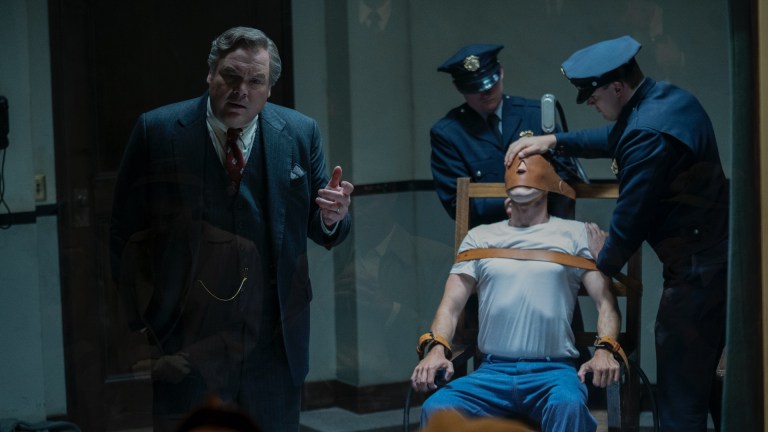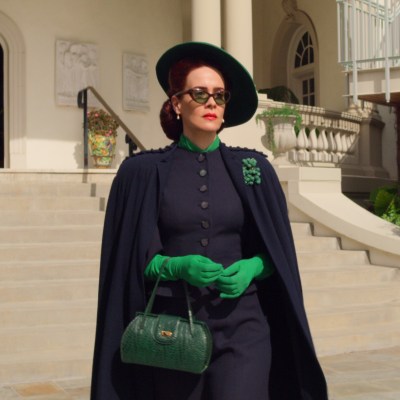Ratched: The Real History Behind the Show’s Medical Procedures
Though the barbaric medical procedures depicted on Netflix's Ratched may seem fantastical, all are based in fact.

This Ratched article contains spoilers.
Ken Kesey’s classic 1962 novel One Flew Over the Cuckoo’s Nest has received a fashionable yet twisted facelift in Ryan Murphy’s Netflix series, Ratched. With this Sarah Paulson-starring series, the American Horror Story creator follows through on his reputation of gruesome twists and jaw-dropping turns.
Ratched forms an interpretation of Nurse Ratched from Kesey’s novel, giving her a backstory that features a clandestine mission and the creation of a monster. Mildred Ratched’s glamorous exterior along with her paradoxical doting behavior towards patients belies her dark side. Nurse Ratched rules the hospital with an iron fist of absolute authority, and very little medical knowledge.
This show blends horror with sexuality and turns it back round again with subplots that scream of American Horror Story.
The series also critiques out-dated and inhumane forms of psychotherapy that were happening in many psychiatric institutions of the time. Viewers of the show have been left aghast at many of the means of treatment – all of which were tragically real.
Hydrotherapy
Hydrotherapy is used today as a form of alternative medicine, occupational therapy, and physiotherapy. The use of water is administered as a form of pain relief. But this “treatment” has a much darker history.
The therapeutic use of water dates back as early as the civilizations of the Ancient Greeks, Romans, and Egyptians who bathed with essential oils and used spring water for ailments.
Throughout the twentieth century, hydrotherapy was used as a treatment for mental illness. Many clinicians believed that when water of different temperatures was applied to the skin, it could trigger reaction throughout the body. Many believed that baths of warmer temperature could help heal those with suicidal thoughts and insomnia. Cold water was used on patients who had manic-depressive psychosis (now known as Bipolar disorder), or showed signs of ‘excitement’. Temperatures could range between 8℃ and 33℃.
However, as R. G. Gordon, a physician to The Royal Mineral Water Hospital in Bath wrote in 1928, there is some “madness which leads physicians to persuade their patients to be boiled, baked, or beaten.” Unfortunately, just like Nurse Betsy Bucket does under Dr Hanover’s orders to treat “lesbianism”, some clinicians would abuse the tools provided and administer temperatures of extremes. Leaving patients burnt, traumatised and severely unwell.
Water known to be cold enough to kill, was also thought to be cold enough to kill mad thoughts – “curing” patients of derangement.
Lobotomies
A lobotomy is a form of psychosurgery. A neurosurgical treatment that is performed for those with mental disorders. It involves severing connections in the brain, with most of the connections to and from the prefrontal cortex being cut, and, the anterior part of the frontal lobes also being disconnected.
Patients were often left incontinent, emotionally blunted and often paralyzed. Walter Freeman suggested that a lobotomy provided a “surgically induced childhood.” A lobotomy is radical, invasive and has severe effects. Many patients lacked any feeling at all, while others were left in a state of complete catatonia – just like Father Andrews after Nurse Ratched gives him an ice pick lobotomy.
This barbaric procedure really was that horrific, and many of the first lobotomies were performed using ice picks and even drills. Even during the 1950s when this procedure was popularised, many experts referred to it as primitive. John F. Kennedy’s sister, Rosemary Kennedy, was delivered in less than desirable birth circumstances, leaving her with a mental deficiency.
In the early 1940s, years before Ratched was set, Rosemary received a lobotomy from Dr. James Watts. Despite warnings, the family proceeded with the operation, without Rosemary’s input at 23 years old. The family immediately knew something was wrong and Rosemary could no longer speak, walk or even see her family. Only after this point did the Kennedys begin to champion the rights of the mentally unwell – realizing what they had done.
A 1951 American study shows that 60% of US lobotomy patients were women, while 74% in Ontario were women. All likely relating to ‘hysteria’, ‘lesbianism’ and being outspoken. Women have always been oppressed throughout history, medicine is not absent from that.
The Soviet Union banned lobotomies in 1950, followed by Germany and Japan. But, lobotomies on a smaller scale are still performed in the United States, the UK and some other European countries. It is thought that up to 50,000 Americans received a lobotomy.
A lobotomy-like procedure – the lobectomy, is actually on the rise. They’re used to treat epilepsy and other seizure disorders. Unlike an ice pick to the eye, these procedures are performed precisely, and, as seizures are able to cause irreparable brain damage, it is sometimes considered better to disconnect the two brain hemispheres so that these seizures simply cannot happen.
Amputation
Doctor Hanover was hired by Ms. Osgood to treat her son Brandon, for piquerism. It’s a real condition that involves the desire to prick people with needles and sharp objects to gain sexual gratification. Doctor Hanover believed that LSD would be a justified treatment for his patient, was spiked himself and the pair had a bad trip. Henry cuts off his own limbs, assuming that he is in a foreign body, and Doctor Hanover proceeds to sew the murdered gardener’s limbs onto Henry’s body. Ultimately, he causes septicemia while working under unsanitized conditions, and without any medicine, and Henry becomes a quadruple amputee.
We know that artificial hands made of metal and wood were used by soldiers as early as 1500. Artificial limbs of other types, such as sticks, can be dated back to around 484 B.C.
French doctor Ambroise Pare reintroduced amputations with ligatures in 1529. But, penicillin (considered the first real antibiotic) wasn’t discovered until 1928, anaesthetic wasn’t kicking about then either. So, for patients who received an amputation before infection could be controlled, their chances, like Henry Osgood, were very slim.
Before anaesthetic was available, amputations had to happen while patients were awake in agonising pain. So, doctors who could sever limbs the quickest became the most popular. Doctor Robert Liston from Scotland, gained the record for amputating a leg in 30 seconds.
The above aren’t the only ‘treatments’ or procedures carried out in Ratched. Unfortunately, there is a lot of murder, abuse, the demonstration of the lethal injection and electric chair and drug abuse throughout this series. People in positions of power are often those shown to be abusing their authority, such as Governor George Wilburn who allows an inmate’s execution to go horribly wrong when the electric chair sets alight, not even wanting to stop the procedure. Patients are even prompted to commit suicide by those supposed to be caring for them. Ratched highlights the problems that often lurked behind what was seen at face value in these historical institutes, suggesting that perhaps those in power were more ‘mad’ than their patients.

